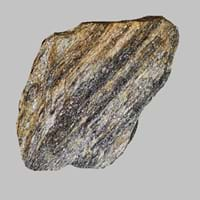Mylonite and Mugearite
Definition
Definition
Mylonite is a metamorphic rock formed by ductile deformation during intense shearing encountered during folding and faulting, a process termed cataclastic or dynamic metamorphism
Mugearite is a type of oligoclase bearing basalt, also comprising of olivine, apatite, and opaque oxides
History
Origin
New Zealand
Skye, Scotland
Discoverer
Unknown
Alfred Harker
Etymology
From Greek mulōn mill + -ite
From mugear + -ite
Class
Metamorphic Rocks
Igneous Rocks
Sub-Class
Durable Rock, Medium Hardness Rock
Durable Rock, Medium Hardness Rock
Family
Group
Not Applicable
Volcanic
Other Categories
Fine Grained Rock, Opaque Rock
Opaque Rock
Texture
Texture
Foliated
Glassy, Massive, Porphyritic, Scoriaceous, Vesicular
Color
Black to Grey
Black, Brown, Light to Dark Grey
Maintenance
Less
Less
Durability
Durable
Durable
Water Resistant
Yes
Yes
Scratch Resistant
Yes
Yes
Stain Resistant
No
Yes
Wind Resistant
No
No
Acid Resistant
No
No
Appearance
Dull, Banded and Foilated
Dull and Soft
Uses
Architecture
Interior Uses
Decorative Aggregates, Interior Decoration
Floor Tiles, Flooring, Homes, Hotels
Exterior Uses
As Building Stone, As Facing Stone, Paving Stone, Garden Decoration
As Building Stone, Garden Decoration
Other Architectural Uses
Curbing
Curbing
Industry
Construction Industry
for Road Aggregate, Landscaping, Roadstone
As Dimension Stone, Cobblestones, Rail Track Ballast, Roadstone
Medical Industry
Not Yet Used
Not Yet Used
Antiquity Uses
Artifacts, Monuments
Artifacts, Monuments, Sculpture
Other Uses
Commercial Uses
Creating Artwork, Gemstone, Jewelry
Creating Artwork
Types
Types
Blastomylonites, Ultramylonites and Phyllonites
Alkaline Basalt, Boninite, High Alumina Basalt, Mid Ocean Ridge Basalt (MORB), Tholeiitic Basalt, Basaltic trachyandesite, Mugearite and Shoshonite
Features
Surfaces are often shiny
Has High structural resistance against erosion and climate, Very fine grained rock
Archaeological Significance
Monuments
Used
Used
Famous Monuments
Data Not Available
Data Not Available
Sculpture
Used
Used
Famous Sculptures
Data Not Available
Data Not Available
Pictographs
Used
Used
Petroglyphs
Used
Used
Figurines
Used
Used
Fossils
Absent
Absent
Formation
Formation
Mylonites are ductilely deformed rocks formed by the accumulation of large shear strain, in ductile fault zones.
Mugearite forms when lava reaches the Earth's surface near an active volcano. The temperature of lava is between 1100 to 1250° C when it gets to the surface.
Composition
Mineral Content
Porphyroblasts
Olivine, Plagioclase, Pyroxene
Compound Content
Aluminium Oxide, Calcium Sulfate, Chromium(III) Oxide, Iron(III) Oxide, Magnesium Carbonate, Silicon Dioxide
Aluminium Oxide, CaO, Iron(III) Oxide, FeO, Potassium Oxide, MgO, MnO, Sodium Oxide, Phosphorus Pentoxide, Silicon Dioxide, Titanium Dioxide
Transformation
Metamorphism
No
Yes
Types of Metamorphism
Not Applicable
Burial Metamorphism, Impact Metamorphism
Weathering
Yes
Yes
Types of Weathering
Biological Weathering, Chemical Weathering, Mechanical Weathering
Biological Weathering, Chemical Weathering
Erosion
Yes
No
Types of Erosion
Chemical Erosion, Sea Erosion, Wind Erosion
Not Applicable
Properties
Physical Properties
Hardness
3-4
6
Grain Size
Fine Grained
Not Applicable
Fracture
Conchoidal
Conchoidal
Streak
White
White to Grey
Porosity
Highly Porous
Less Porous
Luster
Shiny
Not Available
Compressive Strength
1.28 N/mm2
32
37.50 N/mm2
27
Cleavage
Conchoidal
Not Applicable
Toughness
Not Available
2.3
Specific Gravity
2.97-3.05
2.8-3
Transparency
Opaque
Opaque
Density
2.6-4.8 g/cm3
2.9-3.1 g/cm3
Thermal Properties
Specific Heat Capacity
1.50 kJ/Kg K
3
0.84 kJ/Kg K
15
Resistance
Heat Resistant, Impact Resistant, Pressure Resistant
Heat Resistant, Pressure Resistant, Wear Resistant
Reserves
Deposits in Eastern Continents
Asia
China, India, Indonesia, Saudi Arabia, South Korea
India, Russia
Africa
Eritrea, Ethiopia, Ghana, South Africa, Western Africa
South Africa
Europe
England, Finland, France, Germany, Great Britain, Greece, United Kingdom
Iceland
Others
Not Yet Found
Not Yet Found
Deposits in Western Continents
North America
USA
Canada, USA
South America
Not Yet Found
Brazil
Deposits in Oceania Continent
Australia
Central Australia, Western Australia
Not Yet Found
All about Mylonite and Mugearite Properties
Know all about Mylonite and Mugearite properties here. All properties of rocks are important as they define the type of rock and its application. Mylonite belongs to Metamorphic Rocks while Mugearite belongs to Igneous Rocks.Texture of Mylonite is Foliated whereas that of Mugearite is Glassy, Massive, Porphyritic, Scoriaceous, Vesicular. Mylonite appears Dull, Banded and Foilated and Mugearite appears Dull and Soft. The luster of Mylonite is shiny while that of Mugearite is not available. Mylonite is available in black to grey colors whereas Mugearite is available in black, brown, light to dark grey colors. The commercial uses of Mylonite and Mugearite are creating artwork, gemstone, jewelry.
|
||
|
||
|










